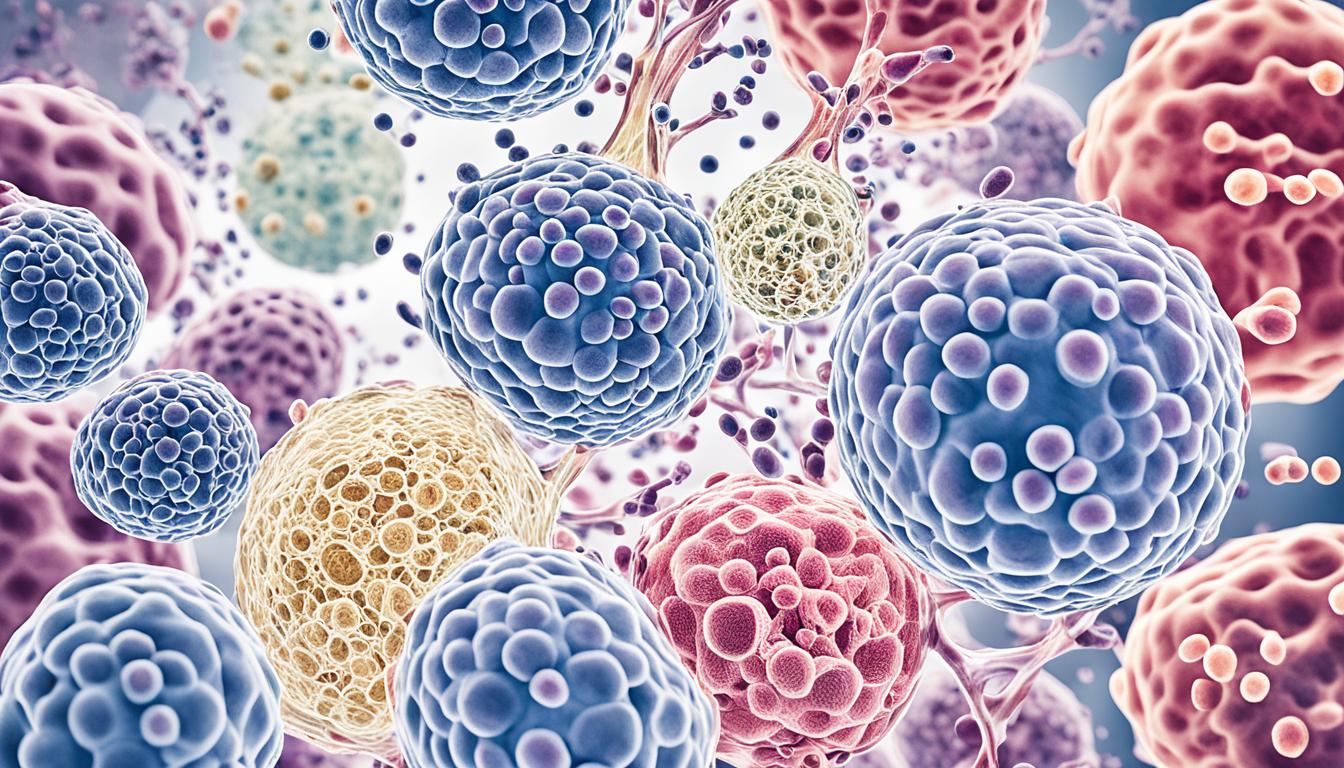Kaposi sarcoma, often called Kaposi’s sarcoma, is a type of cancer that affects blood and lymph vessels. It shows as lesions on the skin or organs. The leading cause is infection with a virus called human herpesvirus 8 (HHV-8). This virus mostly impacts people with weakened immune systems, like those with AIDS.
People with Kaposi sarcoma may notice skin lesions. These can start small but grow bigger and become raised over time. Lesions might look different colors such as brown, blue, red, or deep purple. They can also turn into lumps that might break open and bleed. Kaposi sarcoma can also affect internal organs like the lymph nodes, lungs, liver, spleen, and gut.
Treating Kaposi sarcoma involves different methods. These can include cryotherapy, which is freezing, laser treatments, or cutting off the lesions. Doctors might also use radiation, special creams, drugs, or even a patient’s own stem cells. Stem cell therapy is a new and exciting way to treat this disease.
Key Takeaways:
- Kaposi sarcoma is a type of cancer that affects the cells lining the lymph and blood vessels.
- The main cause of Kaposi sarcoma is infection with human herpesvirus 8 (HHV-8).
- The disease primarily affects individuals with weakened immune systems, such as those with AIDS.
- Common symptoms include skin lesions that can start small and flat and later become raised, with various colors.
- Treatment options for Kaposi sarcoma include cryotherapy, laser treatment, surgical removal of lesions, radiotherapy, topical therapy, chemotherapy, and immunotherapy.
- Stem cell therapy is an innovative treatment approach being explored for Kaposi sarcoma.
Types and Causes of Kaposi Sarcoma
Kaposi sarcoma (KS) is a diverse disease that comes in several types. Each type has its own causes and signs. It’s key to know these to diagnose and treat the disease right. The main types are:
- Classic KS
- Endemic KS
- Transplant-related KS
- AIDS-related KS
Classic KS
Classic KS mainly affects older men from the Mediterranean and Central and Eastern Europe. It is somewhat rare. The disease shows up on the skin, mostly on the legs and feet. At first, spots might be small and flat. But, they can get larger and raised. these spots come in various colors like brown, blue, red, or deep purple.
Endemic KS
Endemic KS is found in Africa’s high-infection areas of HHV-8. It’s more aggressive and develops faster than the classic type. Both adults and kids can get it. It may hit many parts of the body. The skin spots tend to spread quickly and change rapidly.
Transplant-related KS
In people with a new organ or stem cell and on immunosuppressants, transplant-related KS can appear. These drugs keep the body from rejecting the new organ but also lower the immune system. This allows KS to develop. It can grow in many organs and is often very aggressive.
AIDS-related KS
This type is the most common in those with HIV. The virus and a weak immune system pave the way for KS to grow. In AIDS-related KS, the lymph nodes are where it’s often first seen. It tends to grow fast.
HHV-8 and a weak immune system are big parts of KS development. Knowing each type helps doctors target the best treatments. This improves how patients do.
Diagnosis and Treatment of Kaposi Sarcoma
Diagnosing Kaposi sarcoma starts with a biopsy, taking a tissue sample. It’s then looked at under a microscope. This is key in making a clear diagnosis.
The treatment varies based on different facts, like the size and location of the lesions. Also, the patient’s overall health. Many methods can be used, from freezing the area to using lasers or surgery.
Treating Kaposi sarcoma linked to transplants may mean adjusting certain medications. For those with it due to AIDS, therapy to fight HIV might be added. If the disease is advanced, chemotherapy can help manage it better. Clinical trials are also an option for some patients.
For patients, it’s vital to talk openly with their healthcare team. This way, they fully grasp their options. Working with a team of specialists can enhance care and life quality for those with Kaposi sarcoma.

